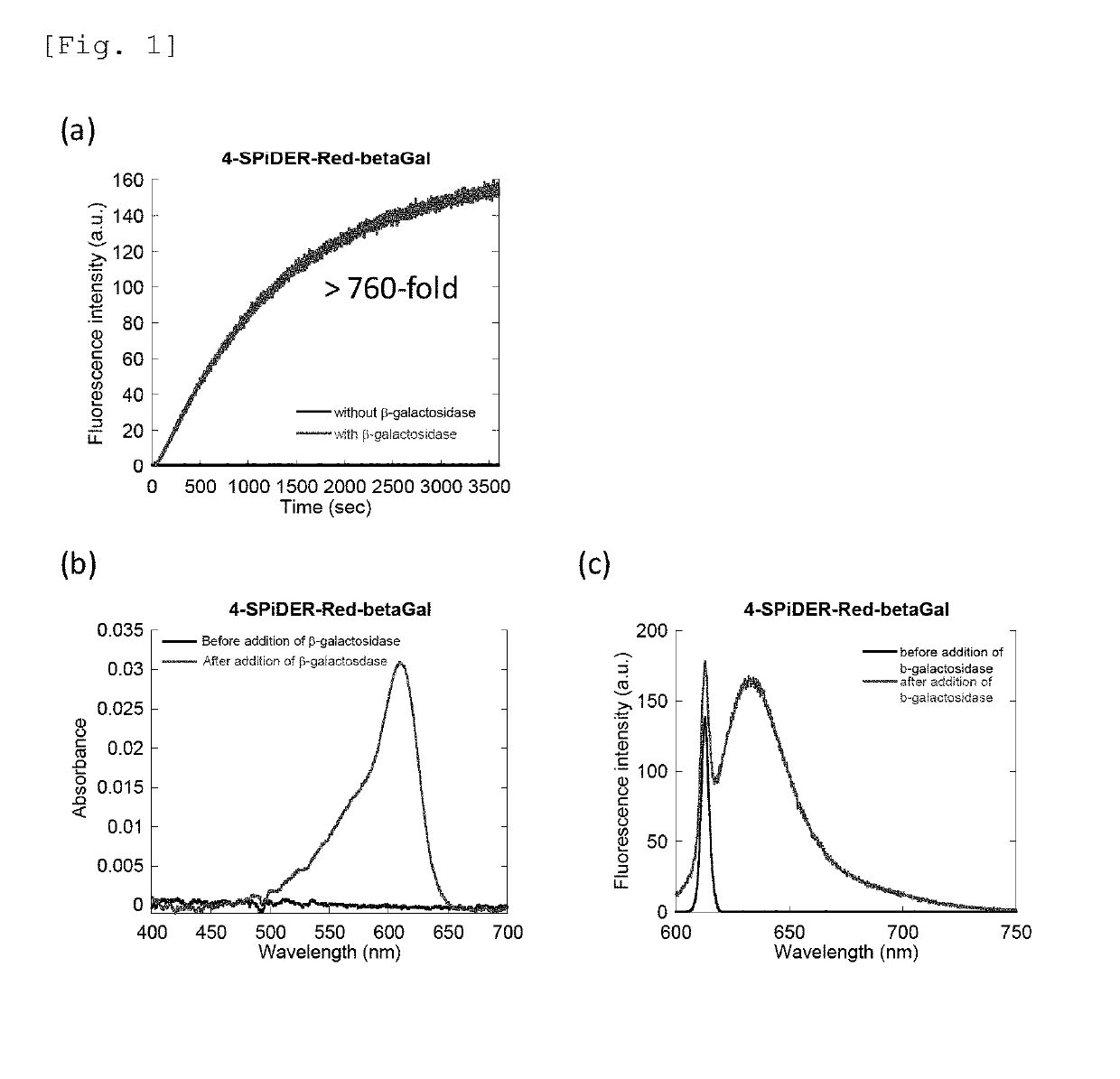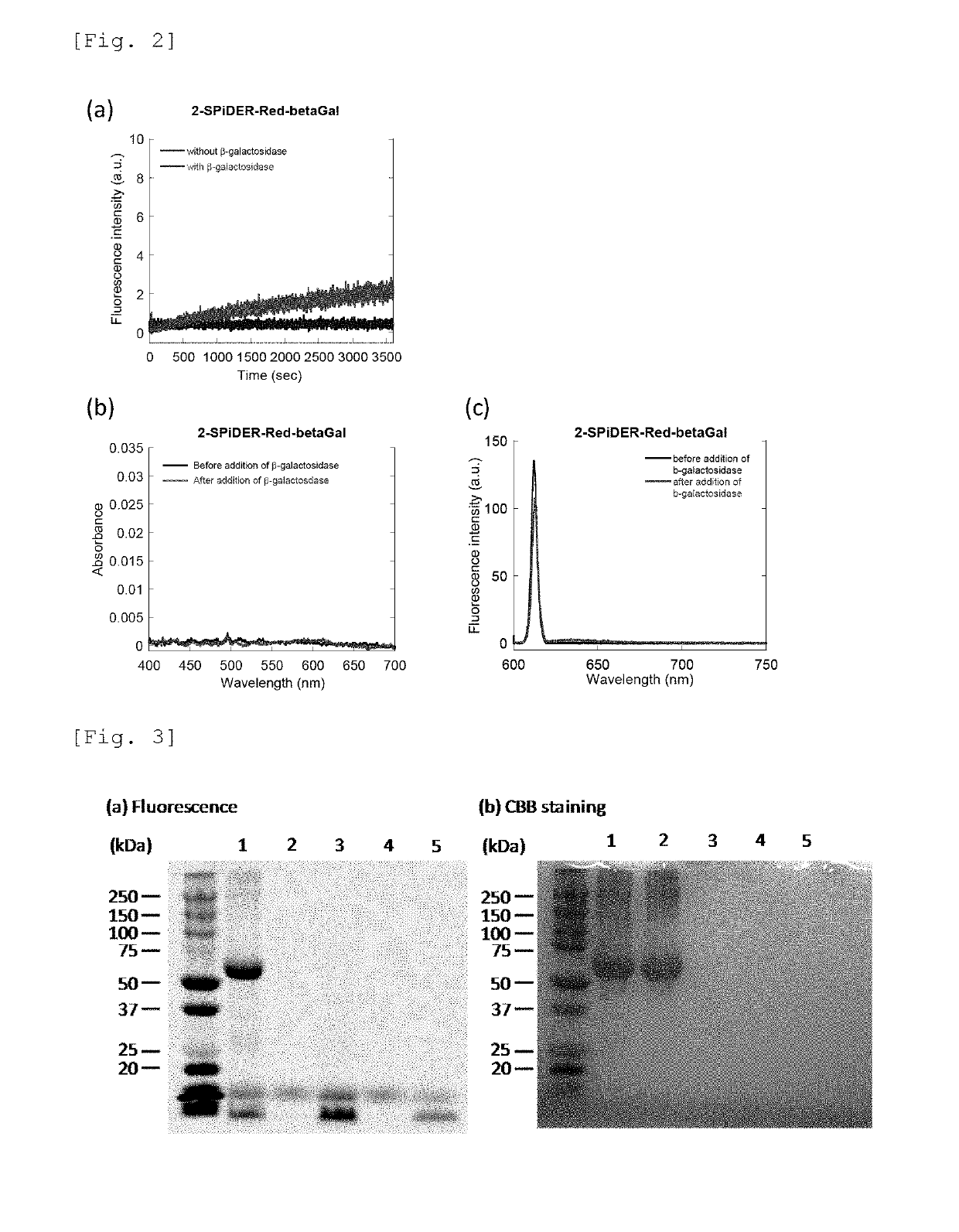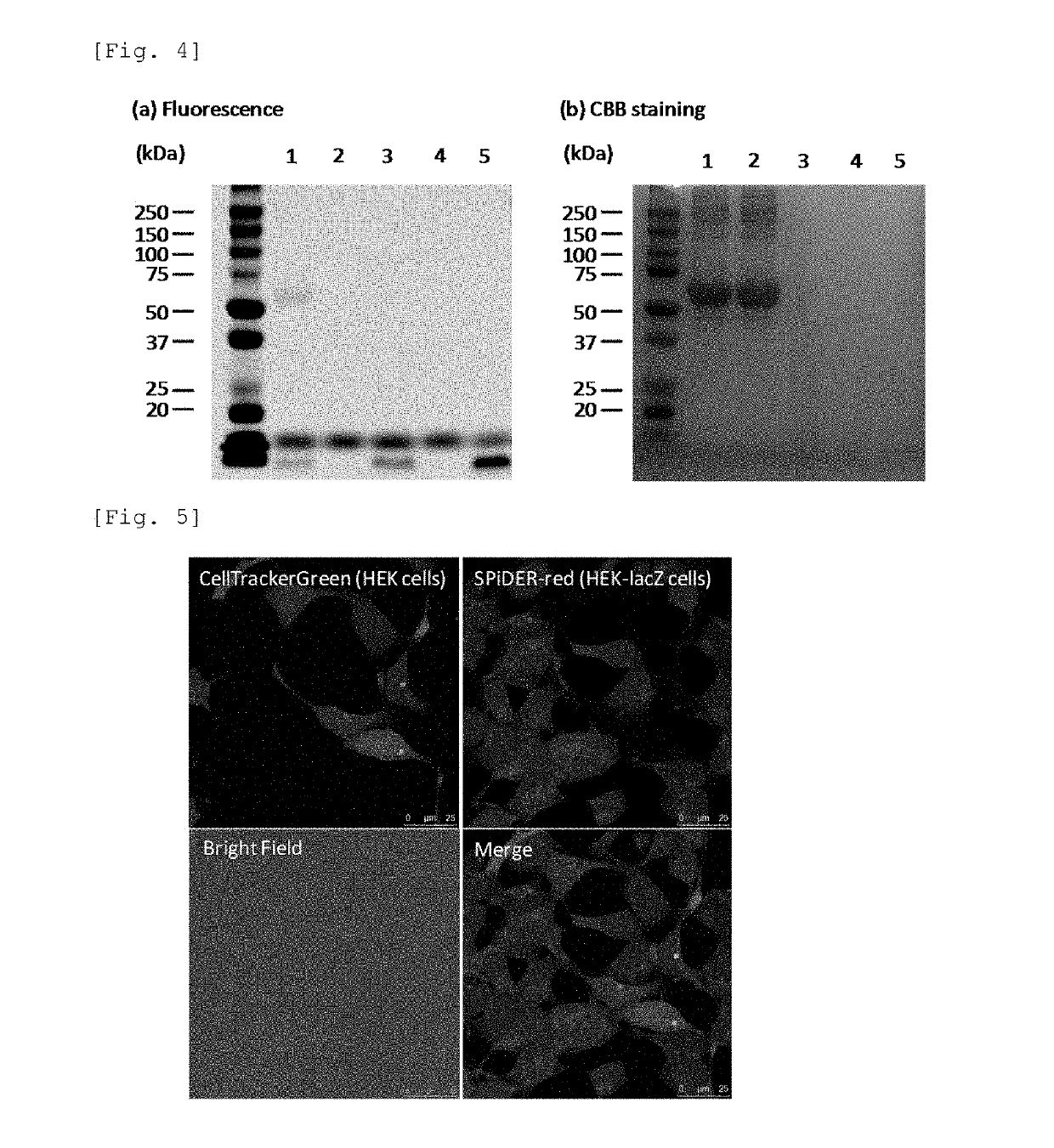Enzyme-specific intracellularly-retained red fluorescent probe
a red fluorescent and enzyme-specific technology, applied in the field of new fluorescent probes, can solve the problems of difficult co-staining with gfp (green fluorescent protein), which is often used in live imaging, and living cells and the like are difficult to clearly image at a single-cell level, and achieve significant industrial utility value and economic effect, and the effect of sufficient cell permeability
- Summary
- Abstract
- Description
- Claims
- Application Information
AI Technical Summary
Benefits of technology
Problems solved by technology
Method used
Image
Examples
example 1
1. Synthesis of Probe Molecule
[0089]4-CH2F-SPiDER-RED-βGal and 2-CH2F-SPiDER-RED-βGal used as an intracellularly-retainable red fluorescent probe of the present invention were synthesized as shown below.
(1) Synthesis of 4-CH2F-SPiDER-RED-βGal
[0090]According to the following scheme, 4-CH2F-SPiDER-RED-βGal which was the intracellularly-retainable red fluorescent probe of the present invention was synthesized.
[Synthesis of Compound 1]
[0091]
[0092]A compound 1 was synthesized in accordance with the previously reported literature (Chemical Communications 47, 4162-4164 (2011)). Specifically, 3-bromoaniline (4.0 mL, 37 mmol) and allyl bromide (11 mL, 131 mmol) were dissolved in MeCN (40 mL) to obtain a dissolved product, to which potassium carbonate (11 g, 80 mmol) was then added. The reaction solution was stirred overnight at 80° C. under an argon atmosphere. After the reaction solution was cooled to room temperature, an insoluble matter was removed by Celite filtration to obtain a filtrat...
example 2
[0147]Changes in Absorption and Fluorescence Spectra by Enzyme Reaction
[0148]For the probe compounds of the present invention obtained in Example 1 (4-CH2F-SPiDER-RED-βGal and 2-CH2F-SPiDER-RED-βGal), changes in absorption and fluorescence spectra according to the addition of β-galactosidase were measured. The measurement results of 4-CH2F-SPiDER-RED-βGal are shown in FIG. 1, and the measurement results of 2-CH2F-SPiDER-RED-βGal are shown in FIG. 2.
[0149]FIG. 1(a) shows the fluorescence intensity of 4-CH2F-SPiDER-RED-βGal by an enzyme reaction upon lapse of time. Measurements were carried out by adding 5U (3-galactosidase to 4-CH2F-SPiDER-RED-βGal prepared at 1 μM in a PBS buffer solution. The measurement conditions are as follows: an excitation wavelength of 610 nm, a fluorescence wavelength of 638 nm, a measurement time of 3600 seconds, a slit (excitation / fluorescence) of 2.5 nm / 2.5 nm, and a photomultiplier voltage of 700 V. FIG. 1(b) shows an absorption spectrum of a 1 μM 4-CH2F...
example 3
[0152]Labeling of Fluorescent Dye to BSA Protein by (3-Galactosidase Enzyme Reaction in Presence of BSA Protein
[0153]Using 4-CH2F-SPiDER-RED-βGal and 2-CH2F-SPiDER-RED-βGal which are the probe compounds of the present invention obtained in Example 1, we have demonstrated that these compounds cleaved by β-galactosidase fluorescently label bovine serum albumin (BSA) protein coexisting therewith in a solution. The measurement results of 4-CH2F-SPiDER-RED-βGal are shown in FIG. 3, and the measurement results of 2-CH2F-SPiDER-RED-βGal are shown in FIG. 4.
[0154]Using 1) 10 μL of a PBS buffer solution containing 10 μM 4-CH2F-SPiDER-RED-1Gal, 1 mg / mL BSA, and 5U β-galactosidase, 2) 10 μL of a PBS buffer solution containing 10 μM 4-CH2F-SPiDER-RED-βGal and 1 mg / mL BSA, 3) 10 μL of a PBS buffer solution containing 10 μM 4-CH2F-SPiDER-RED-βGal and 5U β-galactosidase, 4) 10 μL of a PBS buffer solution containing only 10 μM 4-CH2F-SPiDER-RED-βGal, and 5) 10 μL of a PBS buffer solution containing...
PUM
| Property | Measurement | Unit |
|---|---|---|
| Fluorescence | aaaaa | aaaaa |
Abstract
Description
Claims
Application Information
 Login to View More
Login to View More - R&D
- Intellectual Property
- Life Sciences
- Materials
- Tech Scout
- Unparalleled Data Quality
- Higher Quality Content
- 60% Fewer Hallucinations
Browse by: Latest US Patents, China's latest patents, Technical Efficacy Thesaurus, Application Domain, Technology Topic, Popular Technical Reports.
© 2025 PatSnap. All rights reserved.Legal|Privacy policy|Modern Slavery Act Transparency Statement|Sitemap|About US| Contact US: help@patsnap.com



